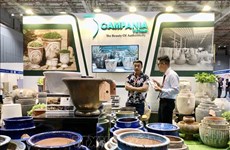Mekong Delta reaps bumper rice crop
The Mekong Delta’s 2013 winter-spring rice harvest was 10.9 million
tonnes, up 200,000 tonnes from last year, said the Ministry of
Agriculture and Rural Development (MARD).
The Mekong Delta’s 2013 winter-spring rice harvest was 10.9 million
tonnes, up 200,000 tonnes from last year, said the Ministry of
Agriculture and Rural Development (MARD).
This is the result of the Ministry’s Plant Protection Department’s close collaboration with the regional provinces in taking measures to prevent and fight insect pests.
The region embarked on an appropriate rice cultivation strategy. High-quality rice varieties for export cover around 70 percent of farmland, while low-quality varieties only account for less than 15 percent of the rice-growing area.
Farmers in the region also used disease-resistant varieties and effective technical methods such as Integrated Pest Management (IPM) to improve productivity and reduce farming costs.
The provinces affected by saline-water intrusion worked together and used water resources effectively to take advantage of all cultivable land.
They applied advanced technical methods and information technology to select and generate rice varieties in connection with ecological protection and sustainable development.
Therefore, most planted rice varieties generate quality rice meeting domestic and export requirements.
The Mekong Delta has established large-scale production with the application of high technology and large-scale rice fields.-VNA
This is the result of the Ministry’s Plant Protection Department’s close collaboration with the regional provinces in taking measures to prevent and fight insect pests.
The region embarked on an appropriate rice cultivation strategy. High-quality rice varieties for export cover around 70 percent of farmland, while low-quality varieties only account for less than 15 percent of the rice-growing area.
Farmers in the region also used disease-resistant varieties and effective technical methods such as Integrated Pest Management (IPM) to improve productivity and reduce farming costs.
The provinces affected by saline-water intrusion worked together and used water resources effectively to take advantage of all cultivable land.
They applied advanced technical methods and information technology to select and generate rice varieties in connection with ecological protection and sustainable development.
Therefore, most planted rice varieties generate quality rice meeting domestic and export requirements.
The Mekong Delta has established large-scale production with the application of high technology and large-scale rice fields.-VNA













